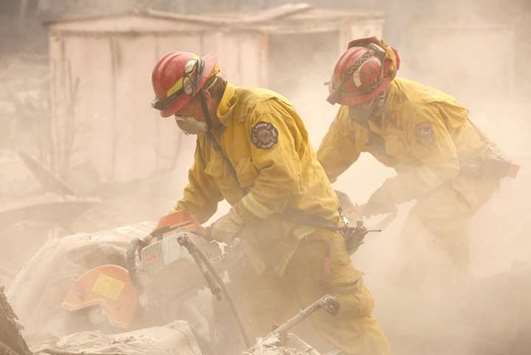The death toll from the Camp Fire remained at 48 overnight but the fire grew 5,000 acres to 135,000, even though diminished winds and rising humidity on Tuesday had allowed firefighting crews to set up containment lines around more than a third of the fire.
The fire, in Butte County about 280km north of San Francisco, remained about 35% contained after burning for nearly a week.
A National Guard contingent of 100 military police trained to seek and identify human remains was going into the town of Paradise, a town of about 27,000 in the Sierra foothills that has been reduced to little more than embers and ash by the Camp Fire.
They were joining coroner-led recovery teams, cadaver dogs and forensic anthropologists already searching the ghostly landscape.
A group of three law firms representing multiple victims of the Camp Fire has filed a lawsuit against Pacific Gas & Electric alleging negligence by the utility company and that “its inexcusable behaviour contributed to the cause” of the blaze.
US Interior Secretary Ryan Zinke and California Governor Jerry Brown were scheduled to tour the area, as well as the site of the Woolsey Fire, where two people have died about 90km west of Los Angeles.
US President Donald Trump has declared both to be disaster areas, making federal emergency assistance more readily available.
Wind-driven flames roared through Paradise so swiftly that residents were forced to flee for their lives with little or no warning.
Nearly 230 people have been listed as missing, but on Tuesday night Butte County Sheriff Kory Honea said those numbers were highly fluid as some individuals may simply have fallen out of touch during chaotic evacuations.
The Camp Fire, fed by drought-desiccated scrub and fanned by strong winds, has capped a catastrophic California wildfire season that experts largely attribute to prolonged dry spells that are symptomatic of global climate change.
Josh Campbell of the California Department of Forestry and Fire Protection told KRCR TV yesterday morning that in at least one instance the strong wind gusts in a canyon near the city of Chico, not far from Paradise, were actually helping by slowing the spread of the fire.
“This gives us the opportunity to construct our lines, so we can be ready for the fire and put it out,” he said.
Anna Dise, a resident of Butte Creek Canyon west of Paradise, told KRCR TV that her father, Gordon Dise, 66, was among those who died. They had little time to evacuate and their house collapsed on her father when he went back in to gather belongings.
Dise said she could not flee in her car because the tires had melted.
To survive, she hid overnight in a neighbour’s pond with her dogs.
“It (the fire) was so fast,” Dise said. “I didn’t expect it to move so fast.”
The Woolsey Fire was the worst of a flurry of blazes in Southern California, having killed two people, destroyed more than 400 structures and displaced about 200,000 people in the mountains and foothills west of Los Angeles.
The fatality count of 48 from the Camp Fire far exceeds the previous record for the greatest loss of life from a single wildfire in California history — 29 people killed by the Griffith Park fire in Los Angeles in 1933.
The origins of both fires are under investigation.
Utility companies Southern California Edison and Pacific Gas & Electric reported to regulators they experienced problems with transmission lines or substations in areas around the time the blazes were first reported.



